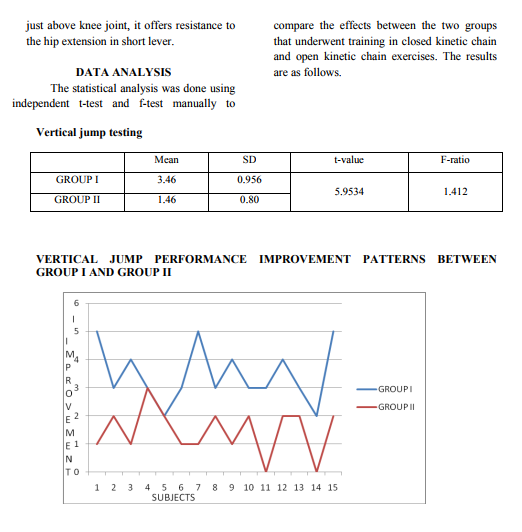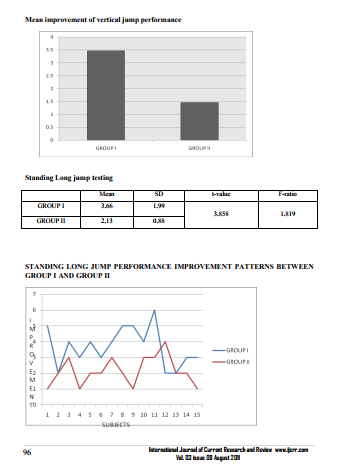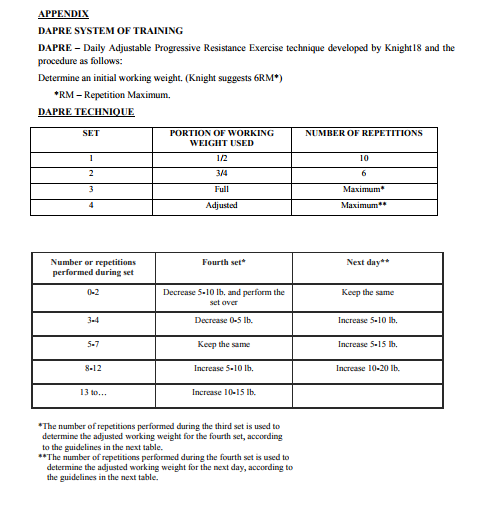IJCRR - 3(8), August, 2011
Pages: 92-100
Print Article
Download XML Download PDF
THE RELATIONSHIP BETWEEN OPEN KINETIC AND CLOSED KINETIC CHAIN STRENGTHENING EXERCISE FOR LOWER LIMB EXTENSORS ON JUMPING PERFORMANCE IN ADOLESCENT MALE BASKETBALL PLAYERS
Author: B.Sankarmani, V.Seetharaman, J.Mohanakrishnan
Category: Healthcare
Abstract:Background and Purpose: The purpose of this study was contribute towards the discrimination of the
effects of open kinetic and closed kinetic chain strengthening exercises. This study aims objectively to
evaluate the benefits of these training modalities and elucidate their effects.
Subjects and Methods: The participants were school basketball players with the average age of 16 years,
divided into two groups randomly to open kinetic and closed kinetic chain strengthening exercises.
Exercises were designed differently for each group and evaluated using vertical jump performance and
standing long jump.
Results: The results shows that closed kinetic chain exercise training were more effective than open
kinetic chain exercise training in improving the jumping performance for the basketball players. The
values of these subjects for closed kinetic chain exercises 3.46+0.956 and 3.66+1.19 when compare to
1.46+0.80 and 2.13+0.88 for open kinetic chain exercises in vertical jump and standing long jump
performance respectively measured in meters.
Conclusion: Closed kinetic chain exercises are more effective in training the individuals who require
jumping as a part of their sports activity and more useful in vertical jumping training which is important
for the basketball players.
Keywords: Closed kinetic chain exercises, Open kinetic chain exercises, Vertical jump, and Standing long jump.
Full Text:
INTRODUCTION
Open kinetic chain leg extension exercises have been the traditional means of strengthening of quadriceps muscle. Closed kinetic chain exercises appear to replicate functional task better, they promote function to a greater extent than Open kinetic chain exercises 1, 2. There is a considerable debate regarding the relative efficacy of open (OKC) and closed kinetic chain (CKC) exercise for increased strength and control of the knee muscles. In general, open kinetic chain (OKC) exercises are single joint movements that are performed in nonweight bearing with a free distal extremity. In contrast, CKC exercises are multi-joint movements performed in weight bearing or simulated weight bearing with a fixed distal extremity 3, 4. CKC has been argued to be more ?functional ?as it simulates he role of lower limb muscles in daily activities 5, 6. It has been argued that proprioceptive feedback differs between CKC and OKC tasks, perhaps due to compression from body mass in CKC8 and pressure under the foot7. Third, CKC exercise has been suggested to produce less shear force between the tibiofemoral joint surfaces as co-contraction of the hamstrings will counteract the anterior tibial shear force generated by the quadriceps9. Jumping is a form of locomotion familiar to man from childhood. It is used for various purposes ranging from a simple expression of joy or exuberance, for competition and of course as an integral part of sport. The significance of jumping in basketball players cannot be understated. The person is only as good as his jumping capacity as far as basketball is concerned. This necessitates the need of jumping training by the concerned coach. Jumping performance can be evaluated in two ways. 1. Vertical jump 2. Standing long jump Leaving the complex biomechanics behind, jumping can be stated as an activity, which primarily involves overcoming the inertia with co-ordination of various muscles contracting in unison to project oneself against the force of gravity. At the outset it should be emphasized that jumping is a wonderful example of closed kinetic chain performance. However individual muscle strength and flexibility are of primary importance when it comes for integrated performance that could be achieved better with open kinetic chain performance. Closed kinetic chain exercise produced significantly greater compression forces and increased muscular cocontraction at the same angles at which the open kinetic chain exercises producedmaximum shear forces and minimum muscular co-contraction10.

It should be noted that this study design doesn‘t have absolute control group as both groups have specific interventions. This goes with the objective of this study, which tries to compare the effects of Open Kinetic Chain and Closed Kinetic Chain exercise training. Study setting This study was conducted at Boys Sports Hostel, Coimbatore. The study was conducted with individual training lasting for six weeks. Sample The subjects were volunteers from the enrolled students of the Sports Hostel basketball team players. The 30 subjects were selected in a non-probability sampling basis and then assigned to 15 each for Group A and Group B in a randomized fashion after giving written consent for voluntary participation. Inclusion criteria: All basketball players of the boys‘ sports hostel who volunteered to participate in the study were included. The age group of the subjects is 15 – 17 male adolescents.
Exclusion criteria: Players who had recent injury or undergoing rehabilitation of previous injuries were excluded.
Outcome measures
The jumping performance was evaluated using two parameters. 1. Vertical jump performance 2. Standing long jump Vertical jump performance: The subjects were made to stand in sideways to the wall with the upper limb fully abducted, elbow, wrist and fingers are extended fully for maximum reach. The jumping performance is recorded by asking the subject to squat as much as possible with clear instruction that the degree of squatting should not exceed the point from which he can‘t optimally recoil. Dipping the middle finger in washable ink and opposing it with the wall on which the measurements are recorded. The subject is then asked to perform the best of his efforts. The performance is recorded as the best that is achieved in three jumps. Standing long jump: The subject is first explained to bend forward as much as possible from where he could jump forwards. The subject was emphasized that he doesn‘t take any step backward before jumping. The measurement is taken from the reference line to the tip of the first landed lower extremity hind foot. As like vertical jump, the best of three jumps are recorded. The subjects were allowed to perform the trial jump in order to understand the concept and to correct any errors. Both these parameters are considered as dependent variables which are highly influenced by the type of training. Training procedure GROUP I - Exercises for closed kinetic chain training [All with resistance accordance with DAPRE system of training (see appendix)] 1. Squat-up Exercises: Starting position: Stand with feet and shoulders wide apart. Movement: Lower the body to a full squatting position slowly and rise back slowly. The upper limb holds the weight as the resistance
2. Lunge Forwards:
Starting position: Subject stands in a walk standing position with one foot kept before the other one. Movement: The subject leans forward by flexing the knee and hip joints to about 90 degrees and bringing the body directly Above the leg that is kept forward. Resistance in the form of a barbell is given over the shoulder.
3. Step-up Exercises:
Starting position: Stand erect with the legs slightly apart in front of the three inches height block. Movement: The subject step-up in the block with one leg and bring the other leg up there by straighten both the legs. Repeat with the other leg to begin the step on and off the block. GROUP II - Exercises for open kinetic chain training [All with resistance accordance with DAPRE system of training]
1. Quadriceps table:
The subject sits on the quadriceps table with the leg stop is positioned at the appropriate position of the leg to provide resistance. The subjects are then asked to perform full range of extension with full control.
2. Calf strengthening Exercises:
The subject is positioned in prone lying, with knee in 90 degrees flexion and ankle in neutral. Weighted boots are then strapped to the person‘s and performs extension of ankle.
3. Hip strengthening Exercises:
The subject stands sideways to the multi-gym equipment such that the resistance string could be position so as to provide resistance to hip extension. Since the subject is standing erect and the block is positioned just above knee joint, it offers resistance to the hip extension in short lever.



RESULTS AND DISCUSSION
Based on t-values calculated, the results are not consistent as shown by standard deviation of these subjects at 3.46 +0.956 and 3.66+1.19 of group I, when compared to the group II values of 1.46+0.80 and 2.13+0.88. The benefits of closed kinetic chain training versus open kinetic chain training concluded by the two pronged approach. Step-1: The first step is to find out the improvements between the groups which were established by using t-test. Based on tvalues calculated at 28 degrees of freedom the values shown that it is greater than the table values. This means that the closed kinetic chain training produces much greater improvements than the open kinetic chain training. Step-2: The second step is to ensure that even though, significant improvements are made by any particular modality of training, we make sure that there is not much of variations when their standard deviations are compared in a ratio. In short, we rule the possibility of inconsistent data by doing an F-test. The F-test values of V1 = 14 and V2 = 14 for P<0.05 is 2.53 according to tables while the calculated values showed F values of 1.412 and 1.819 respectively for vertical jump and standing long jump. Both these values are less than the table values and hence it could be stated that the values are consistent in their variance. The results of this study indicate that a significant positive correlation exists between closed kinetic chain strength of the lower limb extensors and jumping performance. The CKC exercises assist the strength of the three major muscle groups responsible for jumping propulsion: the ankle, knee, and hip extensors. First, CKC has been argued to be more ?functional ?as it simulates the role of lower limb muscles in daily activities. The closed kinetic chain exercises contain more eccentric muscle work, which develops more tension in the muscle and thereby obtains a greater training effect.14This study findings shows that the results are better in closed kinetic chain exercise training. Various studies11,15 suggested that closed kinetic chain exercises are safer than open kinetic exercises because the former place minimal stress on the patella femoral joint in the functional range of movement. The following quotation illustrates the problem with making global statements concerning the functional utility of CKC exercises: "Since the foot is usually in contact with the ground, activities that make use of this closed system are more functional‘‘16 In standing long jump, jumping with 90° knee initial angle with free arm motion creates the longest distances in standing long jump.13 So the subjects are instructed and insisted the importance of the knee flexion during standing long jump. Jump performance appears to be contingent on the quantity and efficiency in which force is produced at the hip, knee and ankle joints.17 The findings of this study are most important to train sports individuals interested in high power sports activities such as vertical and long jumping. The limitations of this study are not including a control group and not examining the mechanisms responsible for changes in jump performance. The results of this study revealed that both groups demonstrated the improvement in jumping performance but better result in closed kinetic chain exercise training.
CONCLUSION
Comparing the values between the groups it could be seen that closed kinetic chain training can be more easily transferred than the open kinetic chain training especially in vertical jump performance. The study concluded that ?Closed kinetic chain exercises are more effective in training the individuals who require jumping as apart of their sports activity and more useful in vertical jumping training which is important for the basketball players?.

References:
REFERENCES
1. Palmitier RA, An K, Scott SG, ChaoEYS: Kinetic chain exercise in knee rehabilitation. Sports Med 11:402- 4 13, 1991.
2. Yack HJ, Collins CE, Whieldon TJ: Comparison of closed and open kinematic chain exercises in the ACL deficient knee. Am J Sports Med 21:49- 54, 1993.
3. Steindler A. Kinesiology of the Human Body under Normal and Pathological Conditions. Springfield, IL: Charles C Thomas, p.63, 1977.
4. Ann-Katrina stensdotter, Paul w. Hodges, Rebecca Mellor: Quadriceps Activation in Closed and in Open Kinetic Chain Exercise: Medicine and science in sports and exercise, 2043-2047, 2003
5. Augustsson, J., and R. Thomee. Ability of closed and open kinetic chain tests of muscular strength to assess functional performance. Scand. J. Med. Sci. Sports 10:164–168, 2000.
6. Fitzgerald, G. K. Open versus closed kinetic chain exercise: issues in rehabilitation after anterior cruciate ligament reconstructive surgery. Phys. Ther. 77:1747–1754, 1997.
7. Kavounoudias, A., R. Roll, and J. P. Roll. The plantar sole is a dynamometric map for human balance control. Neuroreport9:3247–3252, 1998.
8. Kiefer, G., L. Forwell, J. Kramer, and T. L. Birmingham. Comparison of sitting and standing protocols for testing knee proprioception.Physiother. Can. 30–34. 1998.
9. Lutz, G. F., R. A. Palmitier, K. N. AN, and E. Y. S. Chao.Comparison of tibiofemoral joint forces during openkinetic-chain and closed-kinetic-chain exercises. J. Bone Joint Surg. Ser. A 75:732–739, 1993.
10. Escamilla, R. F., G. S. fleisig, N. zheng, S. W. Barrentine, K. E. Wilk and J. R. Andrews. Biomechanics of the knee during closed kinetic chain and open kinetic chain exercises. Med. Sci. SportsExerc. 30:556–569, 1998.
11. Erik Witvrouw, Lieven Danneels, Damien Van Tiggelen, Tine Marieke Willems, Dirk Cambier, Open Versus Closed Kinetic Chain Exercises in Patellofemoral Pain A 5-Year Prospective Randomized Study Am. J. Sports Med. 32; 112, 2004.
12. Bakhtiary AH, Fatemi E. Open versus closed kinetic chain exercises for patellar chondromalacia. Br J Sports Med. 2008 Feb; 42(2):99-102.
13. Wen-Lan wui, Jia-Hroung wit, HwaiTing Lin, Gwo-Jaw wang. Biomechanical Analysis of the standing long jump. Biomed Eng Appl Basis Comm, 2003 (October): 15: 186-192.
14. Bennett JG, Stauber WT. Evaluation and treatment of anterior knee pain using eccentric exercise. Med Sci Sports Exerc 18:526-530, 1986.
15. Woodall W, Walsh J, A biomechanical basis for rehabilitation programs involving the patella femoral joint. J Orthop Sports Phys The: 11:535-542, 1990.
16. Prentice WE. Closed kinetic chain exercise. In: Prentice WE, ed.Rehabilitation Techniques in Sports Medicine. 2nd ed. St Louis, Mo: Mosby; 1994:98-107.
17. Ashley CD, LW.Weiss.Vertical jump performance and selected physiological characteristics of women,J.Strength cond.res,1994:8:5-11
18. Kisner C, Lynn Allen C, Therapeutic Exercise, Foundations And Techniques, FA Davis Company, 2007, Page-125
|






 This work is licensed under a Creative Commons Attribution-NonCommercial 4.0 International License
This work is licensed under a Creative Commons Attribution-NonCommercial 4.0 International License